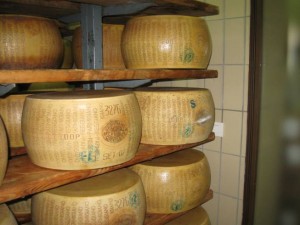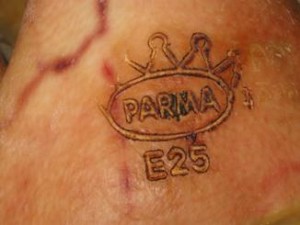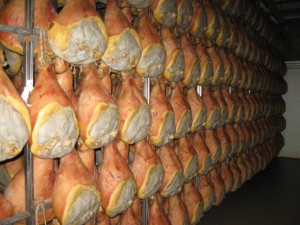Third Day of Cooking School – Ham and Cheese
The third day of cooking school did not require any time in the kitchen classroom. As we learned, the way to serve the ham and cheese of the region requires very little preparation time – you simply break apart the Parmagiano Reggiano cheese into small little chunks and you slice the Proscuitto de Parma into paper thin slices. What is more important is the origins of these two products as there are many copycats of both this type of ham and cheese throughout the world. So off we went to see their origins.
These tours reminded me of my childhood where my father’s idea of “seeing” the country meant seeing all the factories throughout the country. We must’ve toured every factory open to the public as a kid. Now in that ranking system as a kid of the factory tours – both the tours of the Parmagiano Reggiano and the Proscuitto de Parma factories, got high marks. Why? The tours were relatively short and at the end, we had lots of free samples.

Look for this labeling on the cheese rind when selecting Parmagiano Reggiano Cheese. The DOP means it
I learned at the Parmagiano Reggiano cheese factory that local lore says this cheese increases virality in men. I think the quantity required is something more than a little blue pill, but something less than the entire round of cheese. If they lock in on this marketing, the price they can charge for their cheese will soar. However, it will then likely be banned by the US FDA because of the strength of the pharmaceutical lobby. So, keep this a secret please. HOWEVER, you need to get the real deal. Maybe it’s because of what the cows eat in Parma that create this unique feature. It’s a variety of herbs in a grass like mixture. Or it might be the enzymes in the cheese. Maybe the cheese is like wine in that after a couple pieces whoever you’re with just gets more attractive? Maybe it’s a pheromone olfactory aphrodiasiac? That would explain why they love amply endowed woman of short stature who eat a lot of cheese – yes this place is good for my ego.
I also learned that when the cheese maker scores an X on the cheese rind – it does NOT mean X-TRA special. It means the cheese is somehow defective. For some reason, lots of these X-rated cheeses end up in the US being sold as the real thing. Buyer beware.
The stuff that is sold in the little green jars called Parmesaen cheese and the wider distributed small packages of parmesaen cheese are NOT parmagiano reggiano cheese. The real product is a much moister cheese – it actually won’t grate like the cheeses we purchase in the US unless it’s allowed to get stale over several weeks. If you want the real stuff – look for the markings on the rind that are in this picture.
Next it was onto the Proscuitto de Parma factory. Fortunately this was not like a winery in as much as it’s circled by vineyards. It was nice that this place was not circled by pig pens. The ONLY thing in the Proscuitto de Parma were pigs legs. And LOTS of them.
This product was the ultimate in risk management. To create this ham, it has to be salted and kept in the cold for 90 days. The cold salt curing technique is a way to keep the meat from spoiling. I inquired how they did this BEFORE refrigeration as they have been making this type of ham for centuries here. They were only able to make this ham in the time before refrigeration from November to February – probably the reason for the 90 days in the cold with the salt rub. It ages another nine months before it’s ready for consumption. The area around Parma used to be under the sea and there are large deposits of salts. These are the salts used in the sale rubs.

This on a Proscuitto de Parma Ham signifies that it was made in Parma, Italy - the original home of the Proscuitta de Parma
We learned that these are BIG PIGS. These pigs weigh in excess of 400 pounds. There is a copy cat product Made in Canada that got the trademark Proscuitto de Parma BEFORE the real product from Parma secured the trademark. The pigs used in Canada are smaller pigs, weighing less than 200 pounds. So when you see a product that says Proscuitta de Parma – if it’s long and skinny, it’s most likely made in Canada, NOT Parma. The Proscuitto de Parma will have a crown on it that symbolizes it is the real thing. According to some women in our group, you can actually purchase this several times a year at Costco. Also, higher end speciality deli’s in larger cities or in specialty deli’s in the Italian districts in cities will carry it.
We left the factory tour to go visit a very old castle that was now the home of the Grappa manufacturing. Grappa is a product made from the leftover grape skins. Since I am allergic to alcohol, I did not get to sample this one. Based on the looks of my classmates, I considered myself lucky. They reported that it was intense and several had a hard time breathing. We had lunch at the old castle – it was pretty dank and cold there. I’m not sure why living in a castle was anything anyone would want to aspire to in the olden days. Lunch was fun there – lots of pasta and proscuitta de parma.
We got several hours off in the afternoon for good behavior (either that or we had exhausted the staff at Academia Barilla). At 7:30 PM it was on the bus again and off to one of the oldest restaurants in the area located in a small village for a three hour dinner. We were served “traditional” food in an elegant atmostphere. I’m racking my brain to remember what we had – I’m sure it was more ham and cheese.



